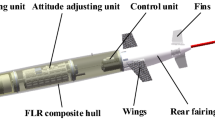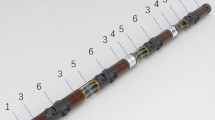Abstract
A flexible hingeless control surface model was proposed for motion control of Underwater Vehicles (UVs), which is inspired by the flexible bending control surfaces of underwater creatures, such as fish and squid. Computational Fluid Dynamics (CFD) simulation demonstrates that, in comparison with the hinged or rigid control surface, the proposed flexible bending control surface can suppress the flow separation so as to improve the turning performance. A prototype of the flexible control surface was fabricated, in which Shape Memory Alloy (SMA) wires were selected as the actuators. The elastic energy storage and exchange mechanism was incorporated into the actuation of the control surface to improve the efficiency. Thermal analysis of SMA wires was performed to find proper actuating condition. Open-loop bending experiments were carried out. The results show that the proposed control surface can achieve the maximum bending angle of 104°. Moreover, the power and energy consumption under different pulse conditions were compared.
Similar content being viewed by others
References
Walker J A. Kinematics and performance of maneuvering control surfaces in teleost fishes. IEEE Journal of Oceanic Engineering, 2004, 29, 572–584.
Walker J A. Does a rigid body limit maneuverability? The Journal of Experimental Biology, 2000, 203, 3391–3396.
Fish F E, Nicastro A J. Aquatic turning performance by the whirligig beetle: Constraints on maneuverability by a rigid biological system. The Journal of Experimental Biology, 2003, 206, 1649–1656.
Fish F E. Biological designs for enhanced maneuverability: Analysis of marine mammal performance. Proceedings of the Tenth International Symposium on Unmanned Untethered Submersible Technology: Special Session on Bio-Engineering Research Related to Autonomous Underwater Vehicles, New Hampshire, 1997, 109–117.
Fish F E. Performance constraints on the maneuverability of flexible and rigid biological systems. Proceedings of the Eleventh International Symposium on Unmanned Untethered Submersible Technology, Durham, New Hampshire, 1999, 394–406.
Chan W L, Kang T, Lee Y J. Experimental characterization of ostraciiform swimming with rigid caudal fins. Proceedings of IEEE International Conference on Robotics and Biomimetics, Bangkok, Thailand, 2008, 222–227.
Xu Y, Zong G, Bi S, Gao J. Initial Development of a Flapping Propelled Unmanned Underwater Vehicle (UUV). Proceedings of IEEE International Conference on Robotics and Biomimetics, Sanya, China, 2007, 15–18.
Bandyopadhyay P R, Castano J M, Rice J Q, Philips R B, Nedderman W H. Low-speed maneuvering hydrodynamics of fish and small underwater vehicles. Journal of Fluids Engineering, 1997, 119, 136–144.
Lagoudas D C, Strelecz J K, Yen J, Kham M A. Intelligent design optimization of a shape memory alloy actuated reconfigurable wing. Proceedings of SPIE, 2000, 3984, 338–348.
Kudva J N, Sanders B, Pinkerton-Florance J, Garcia E. The DARPA/AFRL/NASA smart wing program: Final overview. Proceedings of SPIE, 2002, 4698, 37–43.
Fukuda T, Kawamoto A, Arai F, Matsuura H. Steering mechanism of underwater micro mobile robot. Proceedings of IEEE International Conference on Robotics and Automation, Nagoya, Japan, 1995, 363–368.
Ayers J, Wilbur C, Olcott C. Lamprey robots. Proceedings of International Symposium on Aqua Biomechanisms, Hiratsuka, Japan, 2000, 1–6.
Suleman A, Crawford C. Design and testing of a biomimetic tuna using shape memory alloy induced propulsion. Computers and Structures, 2008, 86, 491–499.
Tomie M, Takiguchi A, Honda T, Yamasaki J. Turning performance of fish-type microrobot driven by external magnetic field. IEEE Transactions on Magnetics, 2005, 41, 4015–4017.
Zhang Z G, Yamashita N, Gondo M, Yamamoto A, Higuchi T. Electrostatically actuated robotic fish: Design and control for high-mobility open-loop swimming. IEEE transactions on Robotics, 2008, 24, 118–129.
Tan X, Kim D, Usher N, Laboy D, Jackson J, Kapetanovic A, Rapai J, Sabadus B, Zhou X. An autonomous robotic fish for mobile sensing. Proceedings of International Conference on Intelligent Robots and Systems, Beijing, China, 2006, 5424–5429.
Nguyen T D, Carpenter B F, Hall J. Flexible tab-assisted control concept (FlexTAC). Proceedings of SPIE, 2001, 4332, 364–370.
Quackenbusha T R, Batcho P F, Bilanin A J, Carpenter B F. Design, fabrication, and test planning for an SMA-actuated vortex wake control system. Proceedings of SPIE, 1998, 3326, 259–271.
Rediniotis O K, Lagoudas D C, Garner L J, Wilson L N. Development of a Spined Underwater Biomimetic Vehicle With SMA Actuators. Proceedings of SPIE, 1999, 3668, 642–653.
Bartol I K, Patterson M R, Mann R. Swimming mechanics and behavior of the shallow-water brief squid Lolliguncula brevis. The Journal of Experimental Biology, 2001, 204, 36–55.
Norberg U M, Rayner J M V. Ecological morphology and flight in bats (Mammalia; Chiroptera): Wing adaptations, flight performance, foraging strategy and echolocation. Philosophical Transactions of the Royal Society of London, B: Biological Sciences, 1987, 316, 335–427.
Balta J A, Bosia F, Michaud V, Dunkel G, Botsis J, Manson J A. Smart composites with embedded shape memory alloy actuators and fibre bragg grating sensors: activation and control. Smart Materials and Structures, 2005, 14, 457–465.
Furukawa Techno Material. Shape Memory Alloys & Super-Elastic Alloys, [2009-09-22], http://www.fitec.co.jp/ftm/english/nt-e/product.htm
Ikuta, K. Micro/miniature shape memory alloy actuator. Proceedings of IEEE International Conference on Robotics and Automation, Cincinnati, Ohio, 1990, 2156–2161.
Wei Z, Sandstrorom R, Miyazaki S. Shape-memory materials and hybrid composites for smart systems Part I Shape-memory materials. Journal of Materials Science, 1998, 33, 3743–3762.
Author information
Authors and Affiliations
Corresponding author
Rights and permissions
About this article
Cite this article
Wang, Z., Li, J., Hang, G. et al. A flexible hingeless control surface inspired by aquatic animals. J Bionic Eng 7, 364–374 (2010). https://doi.org/10.1016/S1672-6529(10)60268-5
Published:
Issue Date:
DOI: https://doi.org/10.1016/S1672-6529(10)60268-5




